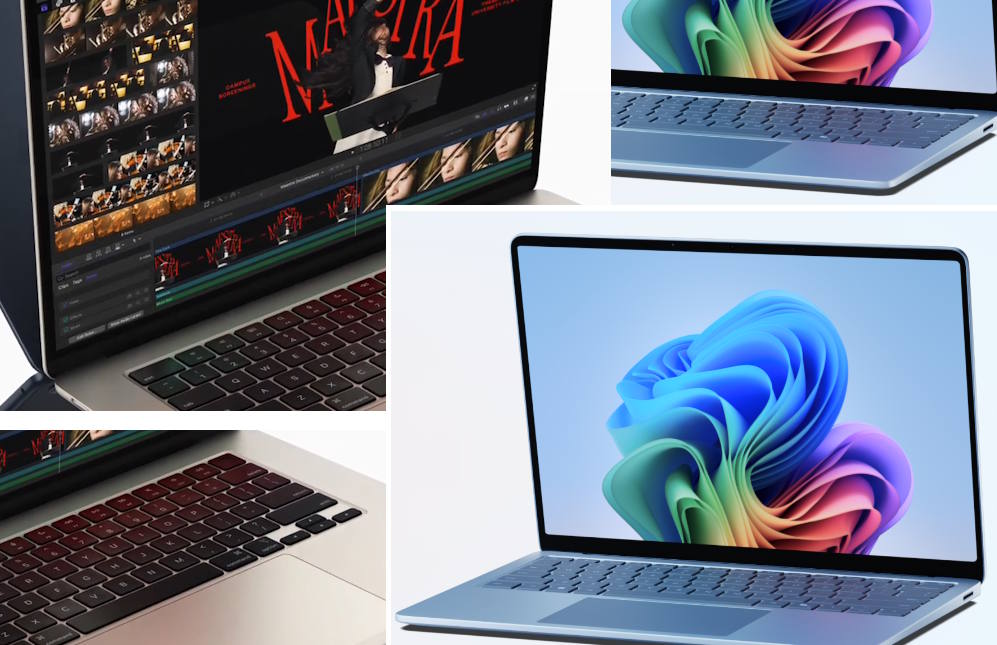For years, Apple’s MacBook Air has been the gold standard for lightweight, premium laptops, setting the bar for performance, design, and battery life. Meanwhile, Microsoft has steadily refined its Surface Laptop series, creating a compelling alternative that blends elegance with productivity. But is the Surface Laptop merely a response to Apple’s dominance, or does it introduce a new way of thinking about modern laptops?
Design and Build Quality: Aluminum vs. Aluminum & Alcantara
Both the MacBook Air and Surface Laptop embrace minimalist aesthetics, but their design philosophies diverge. Apple’s unibody aluminum construction exudes durability and refinement, maintaining a familiar, time-tested look. Microsoft, on the other hand, offers a mix of aluminum and Alcantara fabric in some models, delivering a softer, more inviting touch. While Apple focuses on a uniform metallic finish, Microsoft experiments with colors and textures to create a unique experience.

Operating System and Ecosystem: macOS vs. Windows 11
The fundamental difference between these two devices lies in their software. The MacBook Air runs macOS, a smooth, efficient system tailored for creatives and professionals who rely on Apple’s software ecosystem. In contrast, the Surface Laptop runs Windows 11, offering greater compatibility with a wider range of applications and hardware configurations. While macOS provides seamless integration with iPhones and iPads, Windows 11 brings flexibility, better gaming capabilities, and a more open development environment.
Performance and Hardware: Apple Silicon vs. Intel/AMD Chips
Apple’s shift to its own M-series chips revolutionized the laptop market, significantly improving power efficiency, battery life, and raw performance. The latest MacBook Air models boast exceptional speed while remaining fanless. Microsoft, however, provides more variety, with Intel and AMD-powered Surface Laptops that cater to different users. While Apple’s silicon excels in optimized workflows like video editing and music production, the Surface Laptop maintains a balance of performance and compatibility across different workloads.
User Experience: Touchscreen vs. Touchpad-Only Navigation
One of Microsoft’s defining advantages is the inclusion of a touchscreen, which Apple has avoided on MacBooks. The Surface Laptop supports touch and stylus input, enhancing productivity for artists, designers, and users who prefer a more interactive experience. Apple’s macOS, however, is fine-tuned for trackpad gestures, creating an intuitive interface without needing touch input. The question is whether users value the familiarity of a high-precision trackpad or the versatility of a touchscreen.
Battery Life and Portability: Who Lasts Longer?
Apple’s M-series chips have set a new benchmark for battery efficiency, with the MacBook Air lasting up to 18 hours on a single charge. The Surface Laptop, while offering respectable battery life, generally falls a few hours short of Apple’s endurance. However, Microsoft’s device compensates with more versatile charging options, including support for USB-C and the proprietary Surface Connect charger.
Price and Value: Which Offers More for the Money?
Both devices sit in the premium segment, but Apple’s pricing tends to be more rigid, with fewer configurations and upgrade options. Microsoft provides a wider range of choices, from entry-level models to high-end versions, making it more accessible to a broader audience. For budget-conscious users, Surface Laptops often offer better deals, especially with frequent discounts and educational pricing.
Final Verdict: Alternative or Game-Changer?
The Surface Laptop is undoubtedly a strong alternative to the MacBook Air, but it also brings new ideas to the table. While Apple continues to refine a tried-and-true formula, Microsoft is pushing the boundaries with touchscreens, varied materials, and broader hardware options. Ultimately, the right choice depends on individual preferences—those who prioritize macOS and seamless Apple ecosystem integration will lean toward the MacBook Air, while users seeking versatility, Windows compatibility, and a fresh approach to design may find the Surface Laptop a better fit.
In a rapidly evolving tech landscape, competition between Microsoft and Apple only benefits consumers, ensuring innovation remains at the forefront of modern computing.